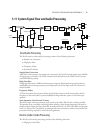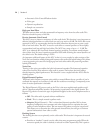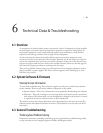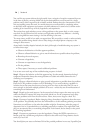76 | Section 6
You can’t fix any system without the right world view; a zeitgeist of suspicion tempered by trust
in the laws of physics, curiosity dulled only by the determination to stay focused on a single
problem, and a zealot’s regard for the scientific method. Perhaps these are characteristics of all
who successfully pursue the truth. In a world where we are surrounded by complexity, where
we deal daily with equipment and systems only half-understood, it seems wise to follow under-
standing by an iterative loop of focus, hypothesis, and experiment.
e notions here apply whether you are solving problems at the system level or at the compo-
nent level. At the system level, the actions you might take would be very different – checking
cables, trying different menu settings – but the thinking is the same.
Too many times, we fall in love with our suppositions. We are quick to overtly or subconsciously
assume the problem being chased is due to lousy design, the stupid phone company, or the
manager’s latest memo.
Armed with a healthy skeptical attitude, the basic philosophy of troubleshooting any system is
to follow these steps:
Observe the behavior to find the apparent problem;
♦
Observe collateral behavior to gain as much information as possible about the problem; ♦
Round up the usual suspects; ♦
Generate a hypothesis; ♦
Generate an experiment to test the hypothesis; ♦
Fix the problem; ♦
en, repeat, if necessary, to attack additional problems. ♦
Let us now cover each step of the troubleshooting sequence in detail.
Step 1. Observe the behavior to find the apparent bug. In other words, determine the bug’s
symptoms. Remember always that many problems are subtle and exhibit themselves via a
confusing set of symptoms.
Step 2. Observe collateral behavior to gain as much information as possible about the problem.
Does the LCD’s problem correlate to an LED flashing? Try to avoid studying a problem in
isolation, but at the same time be wary of trying to fix too many at the same time. No one is
smart enough to deal with multiple problems all at once – unless they are all manifestations of
something more fundamental.
Step 3. Round up the usual suspects. At the system level, always suspect the menu set-up, the
cables, the Phone Company line setup, the punch-blocks, etc. At the component level, many
computer problems stem from the same sources. Never, never, never forget to check Vcc!
Step 4. Generate a hypothesis. Before changing things, formulate a hypothesis about the cause
of the problem. You probably don’t have the information to do this without gathering more data.
Sometimes you will have no clue what the problem might be. Sometimes, when the pangs of
desperation set in, it’s worthwhile to try anything practically at random. You might find a bad
plug, an unconnected line, or something unexpected. Look around, but be always on the prowl
for a working hypothesis.
Step 5. Generate an experiment to test the hypothesis. Change the ISDN connection to a
known good line; call known good phone or hybrid at the other end; if long-distance doesn’t
work, try a local call.
You should plan your tests to eliminate 50% of the possible problems in one test, if possible. Just


















